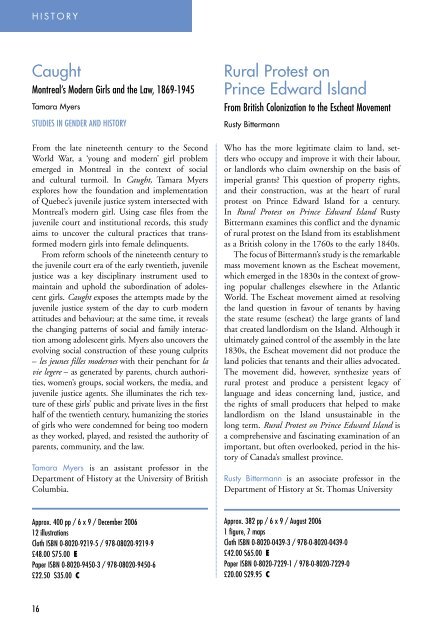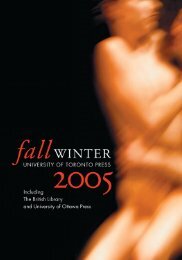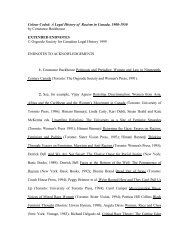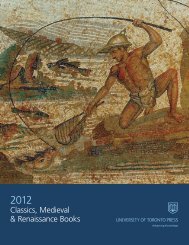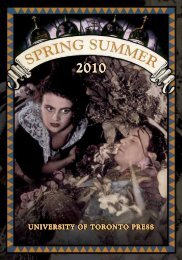Fall/Winter 2006 - University of Toronto Press Publishing
Fall/Winter 2006 - University of Toronto Press Publishing
Fall/Winter 2006 - University of Toronto Press Publishing
You also want an ePaper? Increase the reach of your titles
YUMPU automatically turns print PDFs into web optimized ePapers that Google loves.
H I S T O R Y<br />
Caught<br />
Montreal’s Modern Girls and the Law, 1869-1945<br />
Tamara Myers<br />
STUDIES IN GENDER AND HISTORY<br />
From the late nineteenth century to the Second<br />
World War, a ‘young and modern’ girl problem<br />
emerged in Montreal in the context <strong>of</strong> social<br />
and cultural turmoil. In Caught, Tamara Myers<br />
explores how the foundation and implementation<br />
<strong>of</strong> Quebec’s juvenile justice system intersected with<br />
Montreal’s modern girl. Using case files from the<br />
juvenile court and institutional records, this study<br />
aims to uncover the cultural practices that transformed<br />
modern girls into female delinquents.<br />
From reform schools <strong>of</strong> the nineteenth century to<br />
the juvenile court era <strong>of</strong> the early twentieth, juvenile<br />
justice was a key disciplinary instrument used to<br />
maintain and uphold the subordination <strong>of</strong> adolescent<br />
girls. Caught exposes the attempts made by the<br />
juvenile justice system <strong>of</strong> the day to curb modern<br />
attitudes and behaviour; at the same time, it reveals<br />
the changing patterns <strong>of</strong> social and family interaction<br />
among adolescent girls. Myers also uncovers the<br />
evolving social construction <strong>of</strong> these young culprits<br />
– les jeunes filles modernes with their penchant for la<br />
vie legere – as generated by parents, church authorities,<br />
women’s groups, social workers, the media, and<br />
juvenile justice agents. She illuminates the rich texture<br />
<strong>of</strong> these girls’ public and private lives in the first<br />
half <strong>of</strong> the twentieth century, humanizing the stories<br />
<strong>of</strong> girls who were condemned for being too modern<br />
as they worked, played, and resisted the authority <strong>of</strong><br />
parents, community, and the law.<br />
Tamara Myers is an assistant pr<strong>of</strong>essor in the<br />
Department <strong>of</strong> History at the <strong>University</strong> <strong>of</strong> British<br />
Columbia.<br />
Rural Protest on<br />
Prince Edward Island<br />
From British Colonization to the Escheat Movement<br />
Rusty Bittermann<br />
Who has the more legitimate claim to land, settlers<br />
who occupy and improve it with their labour,<br />
or landlords who claim ownership on the basis <strong>of</strong><br />
imperial grants This question <strong>of</strong> property rights,<br />
and their construction, was at the heart <strong>of</strong> rural<br />
protest on Prince Edward Island for a century.<br />
In Rural Protest on Prince Edward Island Rusty<br />
Bittermann examines this conflict and the dynamic<br />
<strong>of</strong> rural protest on the Island from its establishment<br />
as a British colony in the 1760s to the early 1840s.<br />
The focus <strong>of</strong> Bittermann’s study is the remarkable<br />
mass movement known as the Escheat movement,<br />
which emerged in the 1830s in the context <strong>of</strong> growing<br />
popular challenges elsewhere in the Atlantic<br />
World. The Escheat movement aimed at resolving<br />
the land question in favour <strong>of</strong> tenants by having<br />
the state resume (escheat) the large grants <strong>of</strong> land<br />
that created landlordism on the Island. Although it<br />
ultimately gained control <strong>of</strong> the assembly in the late<br />
1830s, the Escheat movement did not produce the<br />
land policies that tenants and their allies advocated.<br />
The movement did, however, synthesize years <strong>of</strong><br />
rural protest and produce a persistent legacy <strong>of</strong><br />
language and ideas concerning land, justice, and<br />
the rights <strong>of</strong> small producers that helped to make<br />
landlordism on the Island unsustainable in the<br />
long term. Rural Protest on Prince Edward Island is<br />
a comprehensive and fascinating examination <strong>of</strong> an<br />
important, but <strong>of</strong>ten overlooked, period in the history<br />
<strong>of</strong> Canada’s smallest province.<br />
Rusty Bittermann is an associate pr<strong>of</strong>essor in the<br />
Department <strong>of</strong> History at St. Thomas <strong>University</strong><br />
Approx. 400 pp / 6 x 9 / December <strong>2006</strong><br />
12 illustrations<br />
Cloth ISBN 0-8020-9219-5 / 978-08020-9219-9<br />
£48.00 $75.00 E<br />
Paper ISBN 0-8020-9450-3 / 978-08020-9450-6<br />
£22.50 $35.00 C<br />
Approx. 382 pp / 6 x 9 / August <strong>2006</strong><br />
1 figure, 7 maps<br />
Cloth ISBN 0-8020-0439-3 / 978-0-8020-0439-0<br />
£42.00 $65.00 E<br />
Paper ISBN 0-8020-7229-1 / 978-0-8020-7229-0<br />
£20.00 $29.95 C<br />
16


